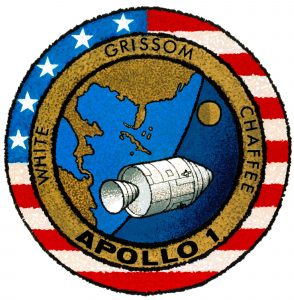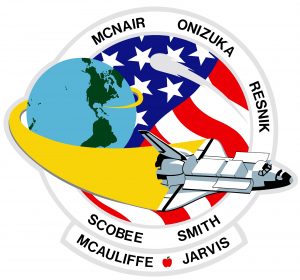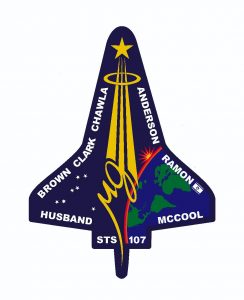Actually I lied. I will do a Memorial Day post, but instead of war and the military, it’s going to be NASA and the space program, as the Space Shuttle program ends this year. Because frankly, I put a lot more stock in exploration and cooperation into discovering new things than killing each other over old things and religion.

Apollo 1 (AS-204) was the first mission in the Apollo program and was to be the first manned test flight of a Command and Service Module (CSM) towards the goal of reaching the moon. Unfortunately a cabin fire during a test launch killed all three crew members, Virgil “Gus” Grissom, Edward H. White, and Roger B. Chaffee. The loss set back the program for over a year while engineers inspected the design of the module and had to make numerous improvements in order to further the mission of reaching the Moon, which was successful with Apollo 11.
At a time when we were still locked in the Cold War with then USSR, it was the dedication of the many folks who helped develop and test the technology that eventually got us to the Moon not once but six times. 12 men can say they have walked on Moon and only 12 have that honor, and had it not been for the tragedy, engineers would have not discovered the flaws in their design. It can be said in science that it often takes a tragedy and the sacrifice of human life to advance forward, and that was first demonstrated early on in the space program. The Apollo program paved the way for advancements in all fields of technology and engineering, and opening the door for further space exploration within our orbit, as well as the Shuttle program, which would drive the next 25 years in space.

Space Shuttle Challenger (STS-51L) was the 25th flight of the Space Shuttle program and the 10th for the Shuttle Challenger (OV-099) having first flown on April 4, 1983. 73 seconds after lift-off, the shuttle exploded, killing all seven astronauts aboard, including Francis “Dick” Scobee, Michael J. Smith, Ellison Onizuka, Judith Resnik, Ronald McNair, Sharon Christa McAuliffe, and Gregory Jarvis. McAuliffe, was the first ordinary civilian to go into space, as part of the “Teacher in Space Project” The cause was due to the failure of an O-ring seal on one of the Solid Rocket Boosters (SRBs). The mission was to deploy a satellite for the Shuttle-Pointed Tool for Astronomy (SPARTAN-203) project, as well as have McAuliffe conduct lessons from space for the Teacher in Space Project and Shuttle Student Involvement Program (SSIP) Unfortunately the project to send a civilian teacher into space was canceled, as NASA opted to hire teachers as astronauts/employees and fully train them.
This mission marked the first significant setback in the modern space program, as it marked the first in-flight accident with all hands lost and first vehicle not to reach space for NASA. It was determined that the O-Ring on the SRB had become too brittle and lost its functionality in the cold temperatures prior to launch, causing the failure in mid-flight. Since then, SRBs have been redesigned to incorporated three instead of two, and heaters around them to keep their temperature consistent. As with all engineering failures, much was learned from the accident that was applied to the space program and all facets of technology and engineering. Many folks who were watching the launch from the areas nearby were shocked and saddened by the events, as well as millions in homes everywhere, as the launch was also televised on national television. One video even surfaced a few years back that was taken by someone’s new handheld camera that caught the explosion as it went into the air. Despite this setback, the space program would continue with STS-26 aboard Discovery on September 29th, 1988.

Space Shuttle Columbia (STS-107) was launched on January 16th, 2003. It spent 16 days in orbit conducting a number of experiments, including the SPACEHAB Double Research Module, as they conducted many microgravity experiments while in orbit. Unfortunately, during landing on February 1st, 2003, the vehicle disintegrated during re-entry, destroying the shuttle and killing all seven astronauts aboard, including Rick D. Husband, William C. McCool, David M. Brown, Kalpana Chawla, Michael P. Anderson, Laurel B. Clark, and lan Ramon who was the first Israeli to go to space. The official cause of the accident was determined to be damage to the thermal protection on the left wing, which was damaged by a piece of foam that came off the main tank during lift-off.
The loss of Columbia was a huge blow for 21st Century spaceflght, as most shuttle missions at this point assisted with the construction and maintenance of the International Space Station. This was Columbia’s (OV-102) 28th mission, having the honor of being the first of the Space Shuttle fleet to launch with STS-1 on April 12th, 1981. The loss marked a significant setback in the program as the ISS relied on shuttle launches for personnel and supplies. Although the Russian Soyuz crafts were able to do the same, the space shuttle was able to carry more cargo than a typical Russian craft at the time, and the loss of Columbia grounded the fleet for two and a half years while engineers worked to make the rest of the shuttle fleet safe for return. The result caused Expedition 6’s crew aboard the station to extend their stay for an extra two months and return with Soyuz TMA-1. With only Soyuz and Progress craft able to deliver supplies and crew to the station for the next two years, ISS crew numbers would be somewhat minimal until the fleet could be cleared to bring up new modules. However, the positives that came out of this accident were also numerous. Research into the design of the fuel tank and the shuttle prompted NASA to create programs for the astronauts to perform in-flight safety checks of the shuttle and her systems after launch and repair problems while in space, reducing the chances of another accident. Technologies developed to do this also assisting in improving the way EVA missions were carried out both on the shuttle and on the station, which no doubt helped the crew of STS-125 complete the refitting of the crippled Hubble Space Telescope. Many tools and procedures developed from the result of the loss of Columbia helped ensure the continued operations aboard the space station.
The important thing to note in space exploration is that it cannot be done without sacrifice, in time, energy, money, and even human life. Throughout NASA’s history, humans have prevailed in developing the technology and means to travel above our planet and discover a world in space that humanity may once live in some day. The numerous contributions to society below as a result of technologies developed by the space program and experiments conducted in space make modern life possible. But most of all, the space program inspired several generations of children to go into math, science, engineering, and technology, and many of those who watched Apollo 11 land on the moon are now floating around in space on manned missions, or have paid the ultimate sacrifice in the name of human exploration.
So while you are honoring the men and women who have served our country in our armed forces this Memorial Day, don’t forget the men and women who have served our country’s space program and have lost their lives in the pursuit of science and exploration. Their sacrifice has ensured that our country remains at the forefront of a reality many once thought as a dream. Never give up on space or our space program, because what we learn today may be what solves our problems of tomorrow.